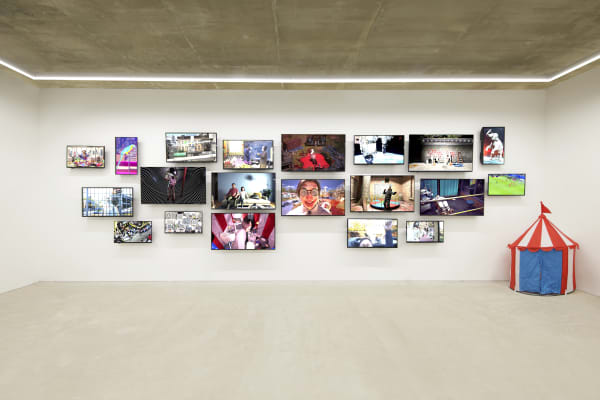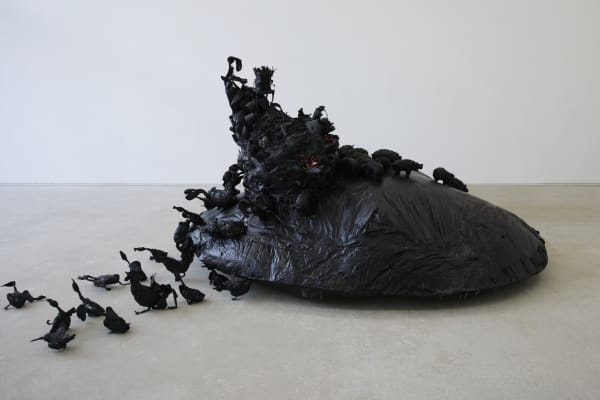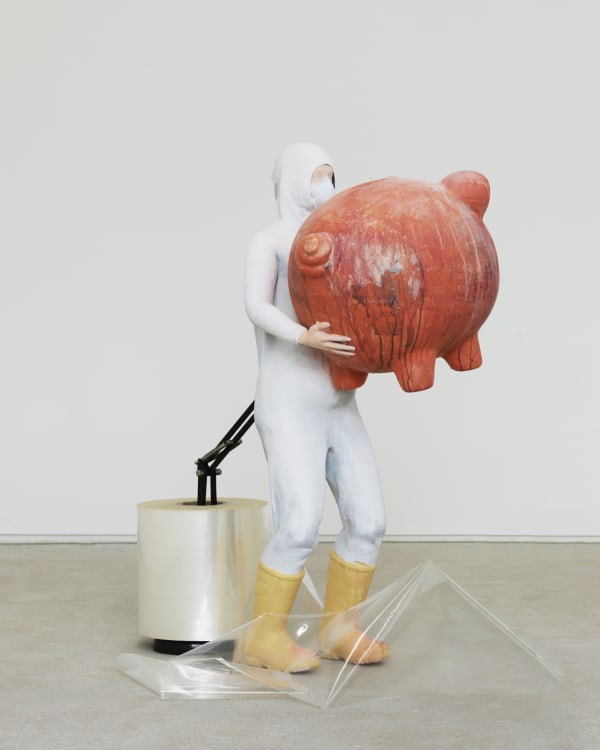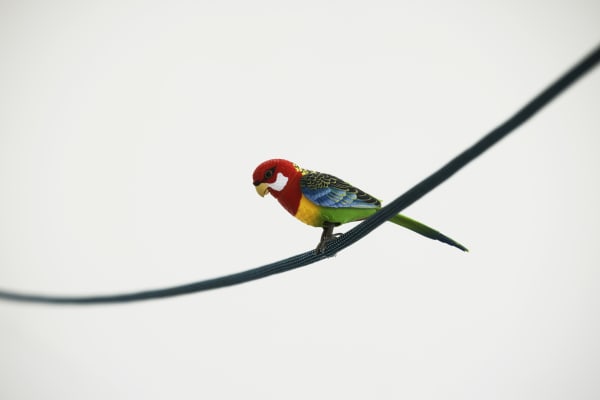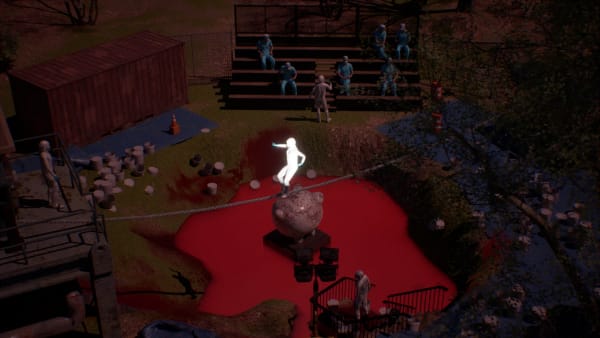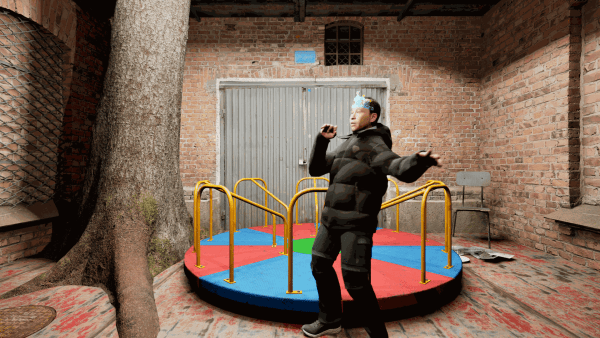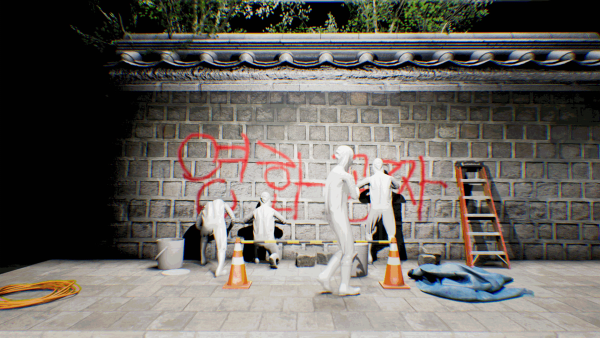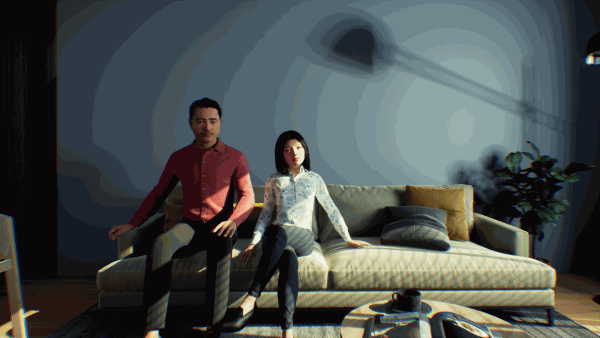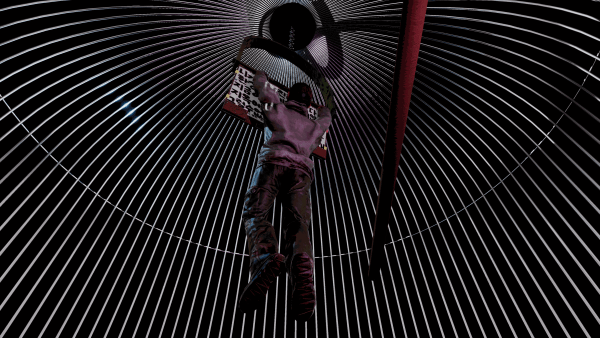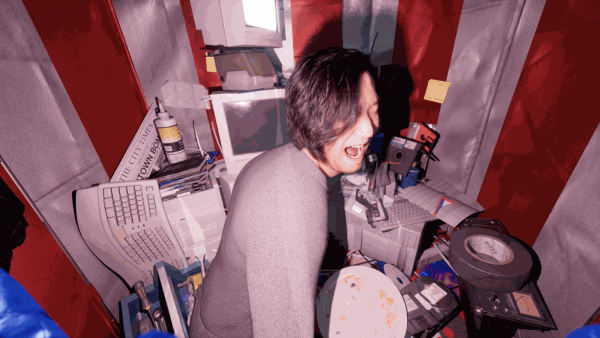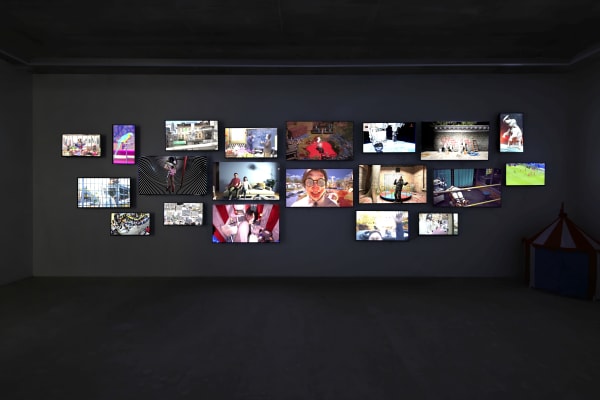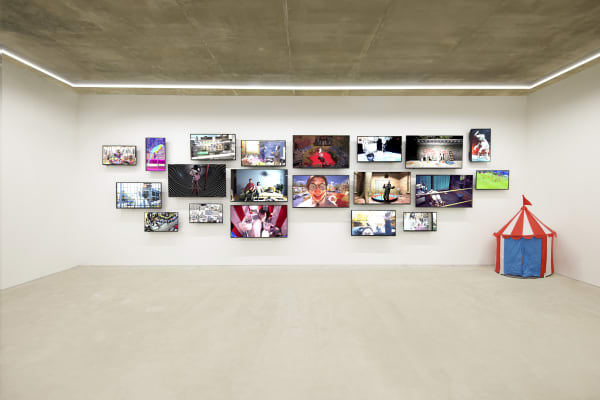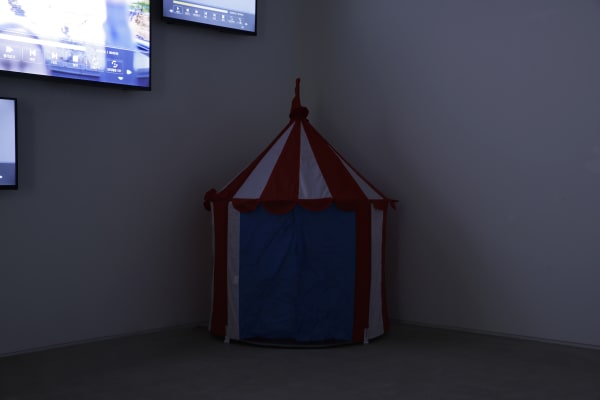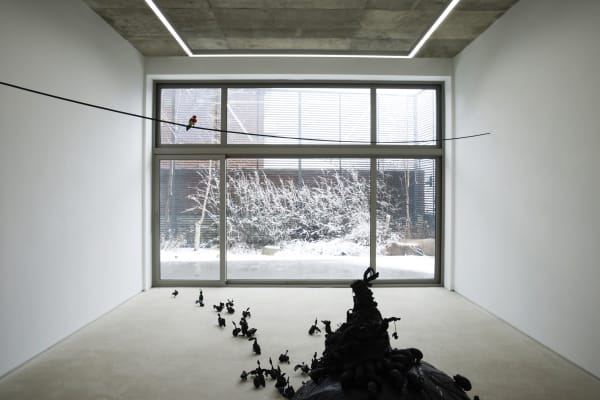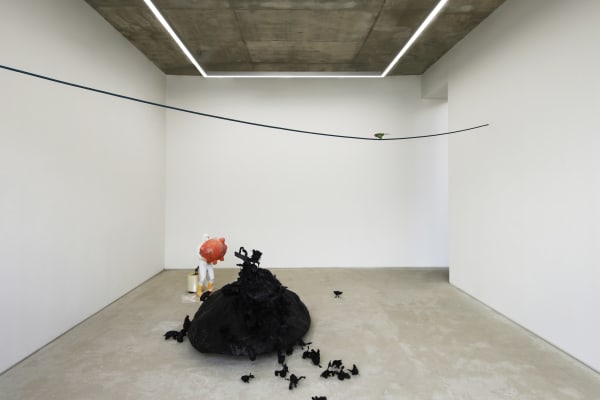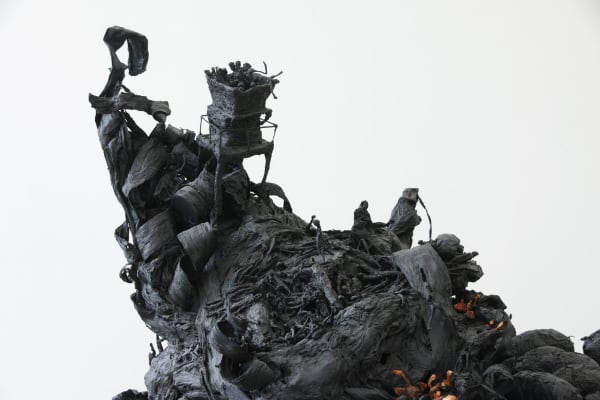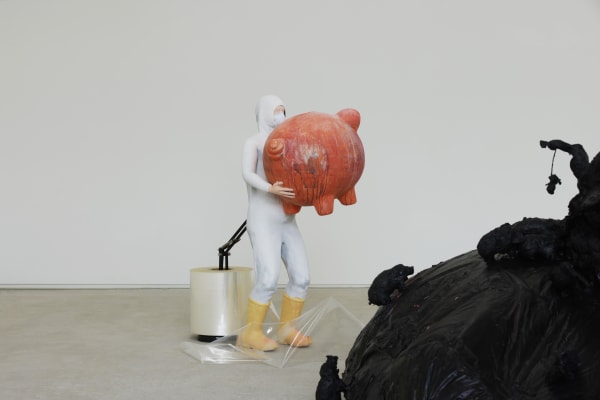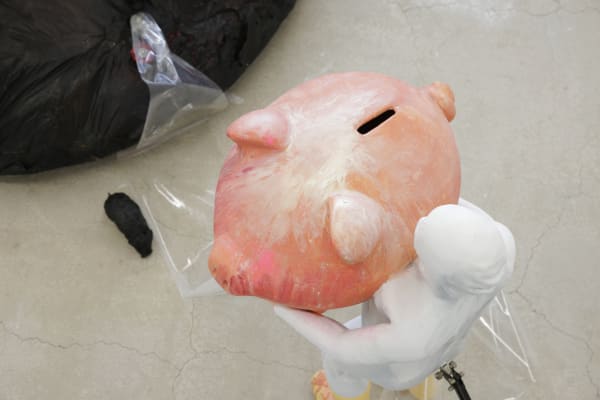서커스 CIRKUS: 김웅현 Woonghyun Kim
당도한 현실, 문제가 도사린다. 붉은 피가 땅에 웅덩이를 만들고 웅덩이 위로 피가 계속해서 쏟아진다. 피는 분쇄기에 의해 멱 따는 소리를 내며 갈린 동물의 것이다. 갈린 동물의 정체는 돼지이고, 그 돼지에게는 병이 있었다. 사람으로 치면 가벼운 감기였다. 치유라는 희망이 환상인 돼지에게 사람과 달리 약을 처방 받을 방도는 없다. 다른 돼지에 병을 옮길 가능성이 있다는 이유로, 그 돼지는 살처분되었다. 여기서 말하는 다른 돼지란 사람이 먹을 식용 돼지다. 즉 병에 걸린 돼지는 사람 몸에 해롭기에 죽는 운명을 맞았다. 그리고 그 운명은 일말의 가능성을 상상한 사람에 의해 결정되었다. 가능성을 상상한다는 건 다른 존재의 명을 좌우할 수 있는 권력의 총체로서 마스터키를 쥐는 일 같은 것이다. 마스터키를 쥔 사람의 존재부터 땅에 웅덩이를 만드는 붉은 피까지, 현실은 문제의 연속이다.
《서커스》는 서커스를 운영하는 한 남자의 이야기다. 그는 이 서커스의 단장이자 피에로이자 해설사로, 약 20분간 여덟 개의 모니터를 오가며 자신이 수집한 여덟 종류의 프릭(Freak)을 소개한다. 프릭을 다루는 서커스. 이곳의 쇼는 17-18세기 서구에서 유행한 ‘프릭쇼(Freak Show)’를 닮았다. 프릭쇼란 일반인과 다른 독특한 외형(일례로 선천적 기형 또는 장애, 의도적으로 변형한 외모)을 가진 사람이 관객을 대상으로 곡예를 하며 신체의 기이함을 전시하는 공연이다. 《서커스》에 속한 프릭은 신체적 특성을 기준으로 그것의 종류가 명명되었던 과거의 쇼와 달리, 상황을 중심으로 분류된다. 돼지를 살처분하는 사람, 앵무새에게 배덕한 말을 가르치는 사람, 정치인을 피습하는 사람, 질소가스로 사형을 집행하는 사람, 괴상해 보이는 가족, 문화재에 낙서하는 사람, 매일 출몰하는 ‘날씨 요정’, 하늘에서 떨어지는 사람. 단장은 여덟 장소를 넘나들며 자신이 모은 여덟 가지 기이한 사람들의 상황을 관객에게 전시한다.
조각이 모인 전시장에는 과거의 것인 척하는 현재의 것이 모여 있다. 이곳에 놓인 조각들은 모니터에서 상영되는 서커스에 등장하는 요소로, 박물관의 유물처럼 선보여진다. 빨간색, 흰색 줄무늬가 반복되는 텐트는 서커스를 상징하는 고전적인 형태를 지녔다. 또한 여덟 종류의 프릭의 상황을 대변하는 물체들이 조각의 문법으로 형상화되어 있다. 텐트를 비롯한 조각들은 먼 과거에 완결된 형체를 보여주는 시늉을 한다. 하지만 궁극적으로 이 조각들은 프릭들에 내재된 상황과 같이 지금 현재에 벌어지는 이야기를 응축한다. 서커스에 관한 보편적인 알레고리를 떠올리게 하는 텐트는 사실 이케아에서 판매하는 값싼 어린이용 세트다. 또한 텐트의 외형은 어디서나 볼 수 있는 편의점 바깥의 파라솔과도 유사하다. 돼지(저금통)를 들고 선 사람, 질소가 가득한 풍선, 외줄의 한 지점에 자리한 앵무새 등 여덟 종류의 프릭 조각들은 모니터 속 서커스의 실황을 일시 정지하여 멈춘 것처럼 보인다. 달리 말해 이곳의 조각들은 (유물처럼) 정지한 척하며 서커스, 또는 우리 주변에서 재생되고 있는 현재라는 시간에 대해 알리려 한다.
그렇다면 《서커스》가 여덟 종류의 프릭을 이용해 알리고자 하는 현재란 무엇일까? 잠시 프릭쇼에 관한 서술로 돌아가 보자. 현대에 와서 프릭쇼는 인권유린을 이유로 점점 사라졌고, 곳곳에서 금지되기에 이르렀다. 동일한 인간의 외형적 다름을 희화화하는 행위가 비윤리적임을 인지한, ‘인류애’의 발전이 낳은 결과라고 할 수도 있겠다. 그런데 정말로 프릭쇼 같은 것이 사라졌을까? 자세히 들여다보면 《서커스》에서 단장이 소개하는 프릭들의 상황은 현재라고 할 만큼 가까운 시점에 일어난 문제를 묘사한다. 불과 2024년 초에 벌어졌거나―예를 들어 이재명 피습, 불법사이트의 경복궁 담벼락 낙서, 아시안컵 축구 경기와 같은 날 맞물린 질소가스 사형집행(과 이에 반대되는 해당 인권 단체의 동물권 침해 행보)―, 그와 멀지 않은 이전의 시간에 촉발한 사건·사고들이다. 즉 《서커스》는 현대화된 윤리의식으로 이해할 수 없는 대상을 발견하는, 발전된 인류애가 아닌 소위 ‘박살 난’ 인류애를 마주하는 프릭쇼 같은 일이 지금도 이 현실에서 펼쳐지고 있음을 말한다.
사실 프릭쇼에는 숨겨진 본질이 하나 있다. 프릭쇼는 전시되는 프릭뿐만 아니라 프릭을 구경하는 관객이 프릭임을 함께 전시한다. 선적인 발전이란 모든 역사에서 의심받는 시나리오다. 시간이 미래를 향한다고 해서 인류의 윤리의식이 무한정 무너지지 않는 상승곡선을 그릴 수는 없다. 사회화라는 것은 어떤 시대에 결정된 일정 수준으로 정의되며, 어느 때에나 완벽한 사회화의 실현은 불가능하다. 인류의 윤리의식, 사회화에 비워진 구멍은 그곳에서 끌어올려질 비윤리성이 있음을 담지한다. 그리고 프릭쇼라는 장르만 종료되고 프릭쇼를 닮은 상황은 멈추지 않고 벌어지는 오늘날. 프릭이라 명명된 《서커스》의 여덟 가지 상황을 보는 우리는, 과거의 쇼와 다른 지금의 시선을 가졌을 뿐, 여전히 전시된 프릭을 구경하고 서 있다.
Reality has sprung, and it is rife with problems. Sanguine spatters down into a thick puddle. The bleeding is much heavier than expected. Something is bleeding, bleeding, bleeding. So it continues, with the shrieking and squealing of final throes; an animal is being put down, or rather, getting stuck with an industrial grinder. It was found unfit, sick, and hopeless; only a mild cold, but colds are for people. Healing and recovery are also for people. A prescription or a cure is out of the question for pigs. And just like that, the pig was determined to be a disease-ridden liability in the pen. It had to go. Had it been disease-free and lived its full term, it would have ended up on the dining table. To put simply, the pig was destined to die the moment it was determined to be harmful for human consumption. And that determination hinged on a swineherd’s imagined potential of contagion and mass loss. The ability to envision future outcomes gives power over those without that ability. With enough potential futures imagined, it becomes indistinguishable to holding the keys to the future. This is problematic. The keyholder’s monopoly over the future, the crimson pool on the ground, reality is just a sequence of one problem after another.
Circus is the story of a man who is a troupe leader running a circus show. As the owner and leader, he is the master of ceremonies, the ring master, and has creative control over shows. He even takes the stage as a clown if he is not emceeing events. Here, he moves about between the eight monitors for 20 minutes, introducing an octet of freaks. This freak show resembles the 17th and 18th century circuses that devolved into freak show tents. A freak show is an exhibition of biological rarities, of persons and animals. Sometimes the exceptional aspect was of appearance (congenital deformities, rare conditions, or altered appearances). At other times, the exceptionality was that of performance, such strange feats and rare displays such as acrobatics. Freaks in Circus display extraordinary performances, presented for their extraordinary situations, rather than the grotesque and shocking physical appearances of yesteryear. The ringmaster introduces to us eight freak situations and persons across eight locations: a person who culls pigs, a person who teaches a parrot to repeat profanities, a person who attacks a politician, an executioner who uses nitrogen gas, a family that simply looks strange, a person who vandalizes national treasures, a ‘weather fairy’ that appears every day, and a person who falls from the sky. The ringmaster ports across eight locations to exhibit the eight strange people and their freakish situations to the (circus) crowd.
In the exhibition hall are a collection of sculptures; anachronistic objects that mimic a sort of history, despite being objects from the present. These sculptures are presented like archaeological artifacts in a museum, but the only ‘past’ they really have are their appearance in the freak-show circus videos running on the monitors. The circus tent is striped in the typical and eye-catching red and white. Eight objects are present, each with a distinct sculptural grammar, each one representing one of the freakish situations on-screen. The circus tent and the other objects take on a type of anachronism, with a faux-classic or fake-retro type of appearance. What these sculptures ultimately do is echo contemporary events that are nothing short of freakish. The typical red-and-white striped circus tent is in fact, a cheap children’s play tent purchasable at IKEA. The radial stripes also resemble the large beach-umbrella type folding-table-fixtures commonly seen outside convenience stores in Korea. The eight freak-sculptures, including the person holding a piggy bank, a nitrogen-filled balloon, and the penguin perched on a bungee line all appear to be suspended in time. That is, by feigning an exhaustion of time in the way that archaeological objects remain at an indefinite epilogue beyond their given time, these sculptures dig up the freak show that is unfolding all around us.
What do the eight oddities of Circus say about our reality? For that, the history and definition of freak show sheds some light. Traced back to popularity in the 16th to 18th centuries, these shows gradually went away for being distasteful in their treatment of people, even becoming outlawed in places. To a degree, it may have come from the recognition that humanity existed beyond what met the eye. Yet as we are presently aware, are those shows truly gone? A closer inspection of the ringmaster’s grotesque situations show that they are very recent; present, even. Some happened only this year, early 2024 or in the months immediately prior. The assassination attempt on Democratic Party leader Jae-myung Lee, the outer wall of Gyeongbokgung Palace vandalized with aerosol paint demarking an illegal website, nitrogen hypoxia execution in Alabama on the day that most of us were watching an Asian Cup soccer match, and the animal cruelty of the human rights group protesting said execution. These were all occurrences that deviate from where modern sensibilities or a modern moral compass might hope for us to be, but those expectations of shared humanity and greater philanthropy are shattered and thrown in the face of turbulent reality.
There is a shared element in all freak shows that we overlook. Haunted house mirrors do a great job of surfacing that element: the audience themselves, peeping and gazing with voyeuristic glee. The concept of “linear development” is dubious, at any point in history. Any point of status in the past’s economy, ethics, or sociocultural development compared to today’s may be arbitrarily drawn as a line, but that is a low-definition map, and hardly the actual territory of landslide drops and downward-diving parabolas. Linear is misleading. In retrospect, social advancement of any society is determined by the society’s own deeds, not its status on a historical line-graph. Furthermore, there never has been a perfect society in that regard. And in that imperfect society of mal-adjusted individuals and misaligned moral compasses, there will always be grotesque happenings. We no longer see pamphlets or posters that promote the genre of exhibitions, but we witness freakish and grotesque happenings around us daily. The eight exhibits of Circus are just that. An exhibit of exhibits, breaking the fourth wall across stage, anachronism, and eventually our suspension of disbelief.
